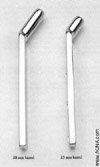DHS TECHNIQUE

Click for enlarged view of image
INDICATIONS
The DHS is indicated for the following fractures of the
proximal femur:
- Intertrochanteric fractures
- Subtrochanteric fractures *
- Basilar neck fractures
The DHS is indicated for stable fractures, and unstable
fractures in which a stable medial buttress can be reconstructed.
The DHS provides controlled collapse and compression of
fracture fragments. This results in a stable fixation
and prevents undue stress concentration on the implant.
* For certain subtrochanteric fractures, a 95° device is the
implant of choice
(See "Using the DCS for Subtrochanteric
Fractures")
PLATE SELECTION
Barrel Length
- The standard 38 mm barrel length is
most commonly indicated
- The 25 mm short barrel is indicated for specific clinical
situations, including:
- Cases in which the standard barrel may not provide
sufficient glide for the lag screw; i.e., a long impaction
distance
is expected.
- A medial displacement osteotomy.
- Unusually small femurs.
Barrel Angle
An evaluation of the angle subtended
between the femoral neck and shaft axes (C.C.D., or
collum-center-diaphysis, angle) of the uninjured femur will
aid in the selection of the most appropriate barrel angle.
The 135° barrel angle is most commonly indicated.
Note
Note: Greater barrel angles may produce biomechanical
advantages in unstable cases; i.e., better gliding characteristics
and reduced bending stresses on the plate/barrel
junction, although correct placement of the implant becomes
technically more difficult as barrel angles increase.(1)
(1) P. Regazzoni, Th. Ruedi, R. Winquist, and M. Allgower, The Dynamic Hip Screw
Implant System (Berlin: Springer-Verlag, 1985) 5.
Next Page
DHS / DCS Index

